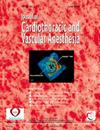Comparison of the Effects of Combined Rhomboid Intercostal and Sub-Serratus Plane Block versus Rhomboid Intercostal Block on Postoperative Analgesia in Patients Undergoing Video-Assisted Thoracoscopic Surgery for Wedge Resection
IF 2.3
4区 医学
Q2 ANESTHESIOLOGY
Journal of cardiothoracic and vascular anesthesia
Pub Date : 2025-05-08
DOI:10.1053/j.jvca.2025.05.003
引用次数: 0
Abstract
Objectives
To compare the analgesic effects of rhomboid intercostal and subserratus plane block (RISS) and rhomboid intercostal block (RIB) on postoperative analgesia in patients undergoing video-assisted thoracoscopic surgery (VATS) for wedge resection.
Design
A prospective, randomized study.
Setting
A single-center tertiary surgery center.
Participants
Sixty patients with American Society of Anesthesiologists class I-III undergoing VATS wedge resection.
Interventions
Ultrasound-guided RIB or RISS block implementation.
Measurements and Main Results
Patients were assigned to the RIB group or the RISS group as part of a multimodal analgesia. In addition to the blocks, multimodal analgesia consisted of paracetamol, tenoxicam, intravenous morphine via patient-controlled analgesia (PCA), and tramadol as a rescue analgesic for both groups, in accordance with the medical literature. Pain scores assessed by the visual analog scale (VAS) at rest and coughing, morphine consumption, rescue analgesic requirements, and side effects were recorded postoperatively for 48 hours. The RISS group had lower VAS scores at rest and with coughing at all time points except 12 hours (for both variables, p < 0.05 at 0 hour and p < 0.01 at 0.5, 1, 2, 4, 8, 24, and 48 hours). The first PCA demand time was significantly longer in the RISS group (p = 0.001). Morphine consumption via PCA was lower in the RISS group at all time points (p < 0.05 at 0 hours and p < 0.01 at 12, 24, and 48 hours). Recovery room stay and mobilization times also were shorter in the RISS group (p < 0.05 for both). Other parameters were similar in the 2 groups.
Conclusions
In this study with a multimodal analgesic approach, RISS provided superior analgesia compared to RIB in patients undergoing VATS for wedge resection.
斜楔切除电视胸腔镜下椎间及锯肌下平面阻滞与斜锥间阻滞对患者术后镇痛效果的比较。
目的:比较菱形肋间及锯下肌平面阻滞(RISS)与菱形肋间阻滞(RIB)对电视胸腔镜下楔形切除术患者术后镇痛效果的影响。设计:前瞻性随机研究。环境:单中心三级外科中心。参与者:60例接受VATS楔形切除术的美国麻醉医师学会I-III级患者。干预措施:超声引导RIB或RISS阻滞实施。测量和主要结果:作为多模式镇痛的一部分,患者被分配到RIB组或RISS组。根据医学文献,除阻滞外,多模式镇痛包括扑热息痛、替诺昔康、患者自控镇痛(PCA)静脉注射吗啡,曲马多作为两组的抢救镇痛药。术后48小时用视觉模拟评分法(VAS)评定休息和咳嗽时的疼痛评分、吗啡用量、抢救镇痛需求及不良反应。除12小时外,RISS组休息时和咳嗽时的VAS评分均较低(0小时时p < 0.05, 0.5、1、2、4、8、24和48小时时p < 0.01)。RISS组首次PCA需求时间显著延长(p = 0.001)。RISS组通过PCA的吗啡用量在所有时间点均较低(0小时p < 0.05, 12、24和48小时p < 0.01)。RISS组的康复室停留时间和活动时间也较短(p < 0.05)。两组其他参数无明显差异。结论:在这项采用多模式镇痛方法的研究中,与接受VATS进行楔形切除的患者相比,RISS提供了更好的镇痛效果。
本文章由计算机程序翻译,如有差异,请以英文原文为准。
求助全文
约1分钟内获得全文
求助全文
来源期刊
CiteScore
4.80
自引率
17.90%
发文量
606
审稿时长
37 days
期刊介绍:
The Journal of Cardiothoracic and Vascular Anesthesia is primarily aimed at anesthesiologists who deal with patients undergoing cardiac, thoracic or vascular surgical procedures. JCVA features a multidisciplinary approach, with contributions from cardiac, vascular and thoracic surgeons, cardiologists, and other related specialists. Emphasis is placed on rapid publication of clinically relevant material.

 求助内容:
求助内容: 应助结果提醒方式:
应助结果提醒方式:


